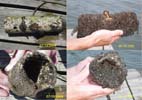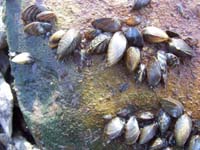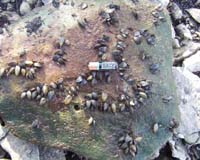sponsored by
Zeiner's Angler Supply
The Kansas Angler Online
and Swim Tail Lures |
Zebra mussels problem
at El Dorado worsens
 August
24, 2005 - El Dorado Reservoir - What a difference a year
has made in the growth and colonization of zebra mussels at El
Dorado Reservoir. August
24, 2005 - El Dorado Reservoir - What a difference a year
has made in the growth and colonization of zebra mussels at El
Dorado Reservoir.
The photo to the right (click on photo for larger view) shows
the difference between the condition of the zebra mussel samplers
in 2004 and 2005. It is not only the samplers that are showing
this increase in colonization as everything that has been in
El Dorado Reservoir for any length of time (2-3 weeks +) will
show encrustation as well.
All lake users are reminded to practice recommended zebra mussel
control precautions before leaving El Dorado Reservoir. Click
here for more details.
Zebra Mussels have
invaded Kansas
and need to be stopped
 Jan. 12, 2004 - El Dorado Reservoir - By now most anglers and boaters are aware of the
discovery of the dreaded Zebra Mussels at El Dorado Reservoir. Jan. 12, 2004 - El Dorado Reservoir - By now most anglers and boaters are aware of the
discovery of the dreaded Zebra Mussels at El Dorado Reservoir.
The barnacle-sized zebra mussel
poses a multibillion-dollar threat to North America's industrial,
agricultural, and municipal water supplies, and it could become
a costly nuisance for freshwater shipping, boating, fishing,
and clamming. First found in 1988 in the Great Lakes, this invader
could become more wide-spread than the common carp and cause
far more economic damage than the Mediterranean fruit fly. Click
on photo for larger view.
Public assistance in reporting
zebra mussell sightings at new locations is essential to help
prevent its spread to other inland lakes and rivers.
 Zebra mussels look like small clams with a yellowish-brown
D-shaped shell, usually with alternating dark- and light-colored
stripes. The can be up to two inches long, but most are less
than an inch. (Click on photo to right to see a comparative size.)
Zebra mussels usually grow in clusters containing numerous individuals
and are generally found in shallow (6-30 feet), algae-rich water. Zebra mussels look like small clams with a yellowish-brown
D-shaped shell, usually with alternating dark- and light-colored
stripes. The can be up to two inches long, but most are less
than an inch. (Click on photo to right to see a comparative size.)
Zebra mussels usually grow in clusters containing numerous individuals
and are generally found in shallow (6-30 feet), algae-rich water.
Zebra mussels are the only freshwater
molusk that can firmly attach itself to firm objects such as
submerged rocks, dock pilings, boat hulls, aquatic vegetation,
and water intake pipes.
If you discover zebra mussels,
note the date and precise location where they were found. Take
one or more mussels with you and store them in rubbing alcohol.
Do not throw them back in the water!
Contact the Kansas Department
of Wildlife and Parks, Research and Survey Office, 1830 Merchant,
P.O. Box 1525, Emporia, KS 66801, (620) 342-0658, or any of the
department's regional offices.
How did they get
here?
The zebra mussel escaped from its
homeland in the Black and Caspian seas in the 1700s and emigrated
to western Europe. From there, it hitched a ride in the ballast
tanks of ships across the Atlantic and through the St. Lawrence
Seaway to the Great lakes. Then adults and larvae spread to the
Illinois and Missippi rivers by barge and boat traffic.
In addition to El Dorado, zebra
mussels have bee found as close to Kansas as the Port of Catoosa
on the Verdigris river in Oklahoma.
Unlike other freshwater mussel
larvae, zebra mussels don't attach to fish or other hosts prior
to adulthood. Consequently, they can easily spread anywhere that
wather currents, wildlife, or human activities take them. One
of the zebra mussel's most effective means of dispersion is travelling
in bilge water of boats.
Why worry?
If the zebra mussel's westward
invasion follows the pattern observed elsewhere, the creature's
population in the Mississippi River will peak in a few years.
For the zebra musse, "peak" population is thousands
per square foot, covering every inch of solid surface down to
45 feet.
Zebra mussels can attach to
anything firm, including water intakes of power generating plants
and unicipal water systems. They can accumulate 6 inches deep,
severely reducing the flow of water and posing a multibillion-dollar
threat to industry, agriculture, and municipal water supplies.
Because of their sheer numbers
(females can produce 100,000 eggs per season), zebra mussels
can smother native freshwater mussel beds.
Fishing News Archives
Back to
Zeiner's Angler Supply | Kansas
Angler Online |
Swim Tail Lures
|